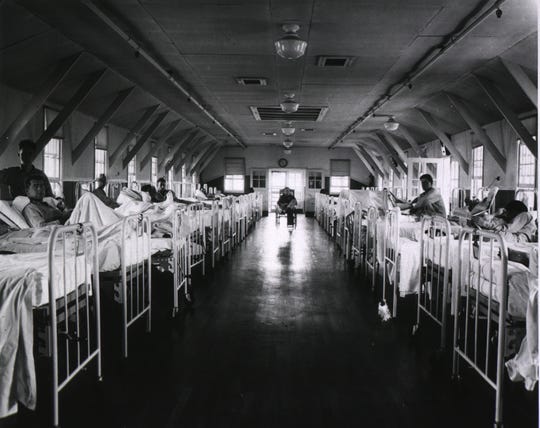Gillian Cobb, Special to Black Mountain News
Published 8:27 a.m. ET May 15, 2019

Asheville and the surrounding areas of North Carolina have long been referred to as “The Land of the Sky” because of the mountainous terrain and beautiful views. This same terrain and its associated climate contributed to the region becoming a hot spot for tuberculosis treatment centers in the late 19th and early 20th centuries.
Many sanatoriums opened up in the area as well as boarding houses designed specifically for tuberculosis patients. Hospitals and doctors were drawn to this area because of the prevailing belief that the outdoors and fresh air would help heal patients and prove valuable for physical therapy.
Tuberculosis, a bacterial disease, is most infamous for attacking the lungs. The disease is airborne, spreading when an infected person coughs, sneezes or even talks.
The first antibiotic to treat tuberculosis, streptomycin, was created in 1943, with new drugs following in the early 1950s to late 1960s. Before antibiotics were created to treat the disease, sanitoriums prescribed sleep, fresh air, exercise, and a healthy diet to cure or lessen the disease’s effects on the body.
The application of these treatments can be seen in the many facilities scattered around Western North Carolina, including the Swannanoa Valley.
Small sanatoriums and tuberculosis treatment centers dotted the landscape and included the Cragmont Sanatorium, built in 1905 as the Harrison Mountain Air Sanatorium, and the Royal League Sanatorium, which also began in 1905.
These small sanatoriums began to shut their doors in the 1940s primarily due to the opening of a much larger, modern facility nearby — the Western North Carolina Sanitorium.
Until the WNC Sanitorium opened in 1937, many of the sanatoriums in the area were exclusive and not open to the public. The WNC Sanitorium was a branch of the N.C. State Sanitorium, and — with the 1950s addition of a wing for African-American patients — allowed any patient to seek treatment there.

During World War I, the US Army built General Hospital No. 19 in Oteen, which still stands today and is operated by the Veteran’s Administration. The hospital was built for the specific purpose of treating soldiers with tuberculosis.
This is not the only time the military laid claim to land in the Swannanoa Valley.
In May 1942, the Army started construction on Moore General Hospital located on U.S. 70, between Swannanoa and Black Mountain. Built on land that was originally part of the State Test Farm, Moore General Hospital was built to serve injured World War II soldiers who intended to return to duty.
The hospital originally had 1,520 beds, then later expanded in 1944 into West Asheville with a new rehabilitation center. The Swannanoa location also included 36 structures to house soldiers who were in training for service in the medical force.
After being treated at the hospital, patients were transported to the rehabilitation center located in the old Sand Hill High School in West Asheville. Here, patients completed their reconditioning classes and were required to attend 3-, 6- and 15-mile hikes.
Along with the clean air, the mountains geography was useful in recuperating soldiers’ bodies, thus preparing them to enter back into the armed forces.
Originally, Moore General Hospital’s focus was not on tuberculosis patients. This changed in September 1946, when the hospital was taken over by the VA.
At this time, it was redesignated as the Swannanoa Rehabilitation Center, dedicated solely to the rehabilitation of tuberculosis patients. Accepting only specific patients, the rehabilitation center provided them with regular medical care, rehabilitation, recreation, social service and vocational guidance.
Patients were able to leave the center with the knowledge of how to best utilize their physical abilities toward resuming day-to-day life. Of the patients admitted to the Rehabilitation Center, over 90 percent completed the program.
In 1960, the VA consolidated its efforts into the Oteen location, and the old Moore General Hospital was deeded to the state of North Carolina. The hospital then turned into a Juvenile Evaluation Center and now is a women’s prison.
Gillian Cobb is an intern at the Swannanoa Valley Museum & History Center.This article was researched using materials from the archives at the museum, which now has an exhibit featuring items from Moore General Hospital including one of the original hand-crank hospital bed frames. This exhibit also gives more context on health care in Western North Carolina.
